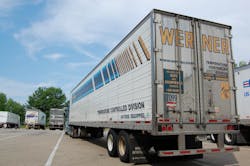Even the recent dip in TL tonnage this June isn’t dampening spirits too much – particularly since the longer-term prospects for truck-based freight seem exceptionally healthy.
Take for example the results from the latest Middle Market Indicator (MMI), a quarterly survey of 1,000 C-suite executives conducted by the National Center for the Middle Market (NCMM) – a collaboration between GE Capital and The Ohio State University Fisher College of Business.
According that poll, 70% of so-called “mid-market” executives – those running businesses with annual revenue between $10 million and $1 billion; businesses that comprise a third of non-government U.S. gross domestic product (GDP) and account for 45.6 million jobs, or one-third of private U.S. employment – expect to see revenue growth in the next year, an 11 point jump from the first quarter this year.
Furthermore, about a quarter of these executives expect to see revenue growth above 10% and as a result they are boosting revenue growth projections by 5.8% or some $130 billion compared to the first quarter survey.
On top of that, those mid-sized firms plan to keep investing, according to NCMM’s findings, with 63% percent planning to on capital expenditures for plant and equipment as well as information technology (IT) – the very stuff that trucks haul.
The interesting part here, according Thomas Stewart, NCMM’s executive director, is that middle market companies grew revenue over the past 12 months at 6.6%, nearly twice as fast as the S&P 500 at 3.4%, which is one reason why executive confidence in the U.S. economy hit 68% in the group’s most recent survey.
“For the second quarter in a row, U.S. middle market companies turned in exceptionally strong growth in revenue along with solid gains in employment,” Stewart said in a statement. “Mid-market executives seem to be determined to translate revenue increases into solid productivity improvements by holding the line on investments in capital and labor both.”
Trucking is benefitting from such activity, as indicated by earnings results from the second quarter.
Take Werner Enterprises, for example. Though its net income slipped compared to last year’s levels – despite higher revenues – Werner is witnessing mileage and revenue-per-truck increases, which bode well for the rest of 2014.Werner posted a 1% decline in net income to $25.6 million on 7% higher revenues of $542.1 million in the second quarter this year compared to the same period in 2013, with net income falling 8% to $39.9 million on 3% higher revenues of $1.03 billion during the first half of 2014 compared to the first half of 2013.
“Average revenues per tractor per week, net of fuel surcharge, increased 4.9% in second quarter of 2014 compared to second quarter of 2013. This was achieved as a result of planned network design changes that enabled us to increase our average trip length by 5.7% which improved average miles per truck and reduced empty miles while also producing an expected negative impact on revenue per mile,” the carrier said in its earnings statement.
“Even after these changes, average revenues per total mile, excluding fuel surcharge, rose 2.1% in second quarter of 2014 compared to second quarter of 2013,” Werner added. “We made good progress working with our customers on sustainable rate increases during second quarter 2014. These efforts will continue as we move forward and work to recoup the cost increases associated with more expensive equipment, a shrinking supply of qualified drivers and an increasingly difficult regulatory environment.”
Tight capacity combined with rising freight demand is what Werner believes will be the winning ticket for trucking down the stretch.
“Positive freight demand trends continued from the first quarter into second quarter in 2014,” the carrier noted. “Freight demand showed consistent strength and we were overbooked [with] more available freight than available trucks at the start of each day throughout second quarter. Tight capacity combined with a gradually-firming economy was the primary contributing factors. This trend has continued through the first three weeks of July.”
Werner also pointed out that truck capacity is being constrained by an extremely challenging driver market, accelerating trucking company failures and heightened regulatory cost increases for truck ownership and safety. “Thus, we expect this favorable freight trend will continue,” the carrier stressed.NCMM’s survey, though, indicates that driver recruiting challenges are only going to get amplified as the industrial sectors expected to grow the most in the coming months are the very ones that will siphon off potential big rig operator candidates.
The manufacturing and health care sectors in particular increased performance over the last year, NCMM reported, with 72% of mid-sized manufacturers reporting higher revenue growth, with an average year-over-year growth rate of 7.3%.
Looking ahead, the group said four mid-market industry sectors are particularly optimistic about their prospects over the next 12 months, with three out of four saying they will growth revenue well above the national average: construction (8.1%), services (8%), manufacturing (7.2%), and financial services (6.7%), with mid-sized construction firms planning to hire new employees at a rate of 5.1% over the next 12 months.
That’s the kind of hiring wave Werner believes will make the driver recruiting environment even tougher.
“Significant problematical factors include a declining number of, and increased competition for, driver training school graduates, a gradually declining national unemployment rate and job competition from the housing construction and hydraulic fracturing markets,” the carrier emphasized. “We expect that competition for drivers will further intensify in the coming months.”
Still, when taken in total, things keep looking good for trucking. And you can never have enough positive vibes in the rough-and-tumble truck freight world, at least from where I sit.






